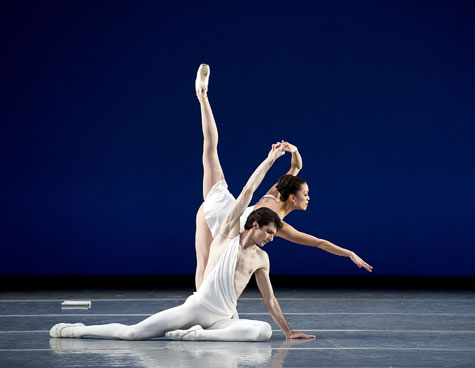Boston Ballet’s ‘Ultimate Balanchine’
By JEFFREY GANTZ | May 13, 2010
 APOLLO Lia Cirio and Pavel Gurevich try to locate the center of the universe. |
| “ULTIMATE BALANCHINE” | The Four Temperaments | Music By Paul Hindemith | Apollo | Music By Igor Stravinsky | Theme And Variations | Music By Pyotr Tchaikovsky | Choreography By George Balanchine | Costume Design By Jens-Jacob Worsaae [Theme And Variations] | Lighting By John Cuff | Staging By Sandra Jennings [The Four Temperaments], Ben Huys [Apollo], And Merrill Ashley And Russell Kaiser [Theme And Variations] | With The Boston Ballet Orchestra Conducted By Jonathan McPhee | Presented By Boston Ballet At The Opera House Through May 16 |
George Balanchine was famous for “non-story” ballets, but when you put three of his works — the usual number to fill up an evening — together, you always get some kind of narrative. Take Boston Ballet’s “Ultimate Balanchine” trio, which opened at the Opera House last night. Apollo (1928) appears to be about the birth of dance, as the god, his curiosity piqued by the syncopated four-note motif Stravinsky has given him, passes on Muses Calliope (poetry and its rhythm) and Polyhymnia (mime) to partner with Terpsichore (who combines what her sisters offered) before ascending to Mount Parnassus. The Four Temperaments (1946) fragments Terpsichore into the four title humors, with dancing that’s a lot more down to earth. Then Theme and Variations (1947) follows Apollo to Parnassus — it’s dance as apotheosis, Russian-style.At least, that’s my narrative. Boston Ballet artistic director Mikko Nissinen must have his own version, since he’s chosen to start “Ultimate Balanchine” with The Four T’s and then go to Apollo. Never mind, what counts in Balanchine is not the story but the sensibility. And, opening night, dancing the solo part in the last of The Four T’s, Choleric, Kathleen Breen Combes had it, exploding from her gut into all four limbs and shimmying through Paul Hindemith’s spiky score as if there were no bar lines. It was the evening’s Parnassus but by no means the only peak on a program of works that, even by Balanchine standards, can fairly be called “Ultimate.”
The Four T’s has its own mini-narrative: a three-part Theme and then four Variations — Melancholic, Sanguinic, Phlegmatic, Choleric — each treating the Theme’s three parts. (When, back in 1977, The Four T’s was taped for PBS’s Dance in America series, the cyc backdrop was color-coded: blue for the first part, yellow for the second, red for the third. These days, everything is blue.) The Theme posits a war between the sexes, each part with its own couple, the men standing behind the women, in control — perhaps. As in so much of Balanchine, it’s also a war between point and flow (or particle and wave); of the three couples last night, it was the third, Megan Gray and Sabi Varga, who managed to give us both.
 Topics
Topics:
Dance
, Entertainment, Entertainment, Opera House, More  , Entertainment, Entertainment, Opera House, Opera House, Marcel Duchamp, John Lam, Rie Ichikawa, Nelson Madrigal, Carlos Molina, Erica Cornejo, Less
, Entertainment, Entertainment, Opera House, Opera House, Marcel Duchamp, John Lam, Rie Ichikawa, Nelson Madrigal, Carlos Molina, Erica Cornejo, Less 